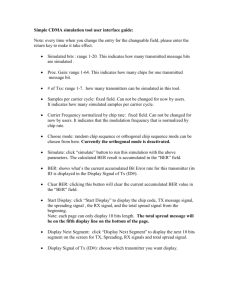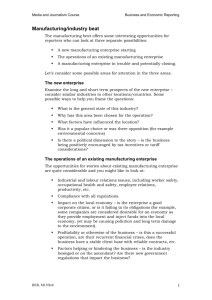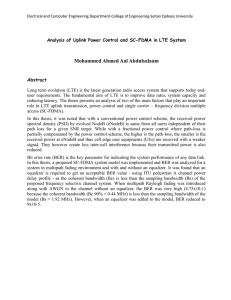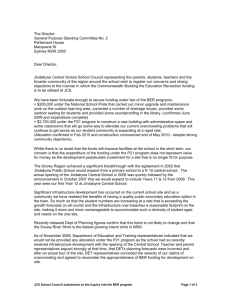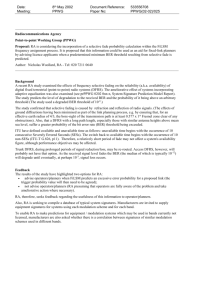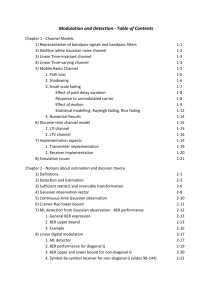Estimation of Ber for M-Ary PSK System using Semianalytic Method 5- April2015
advertisement
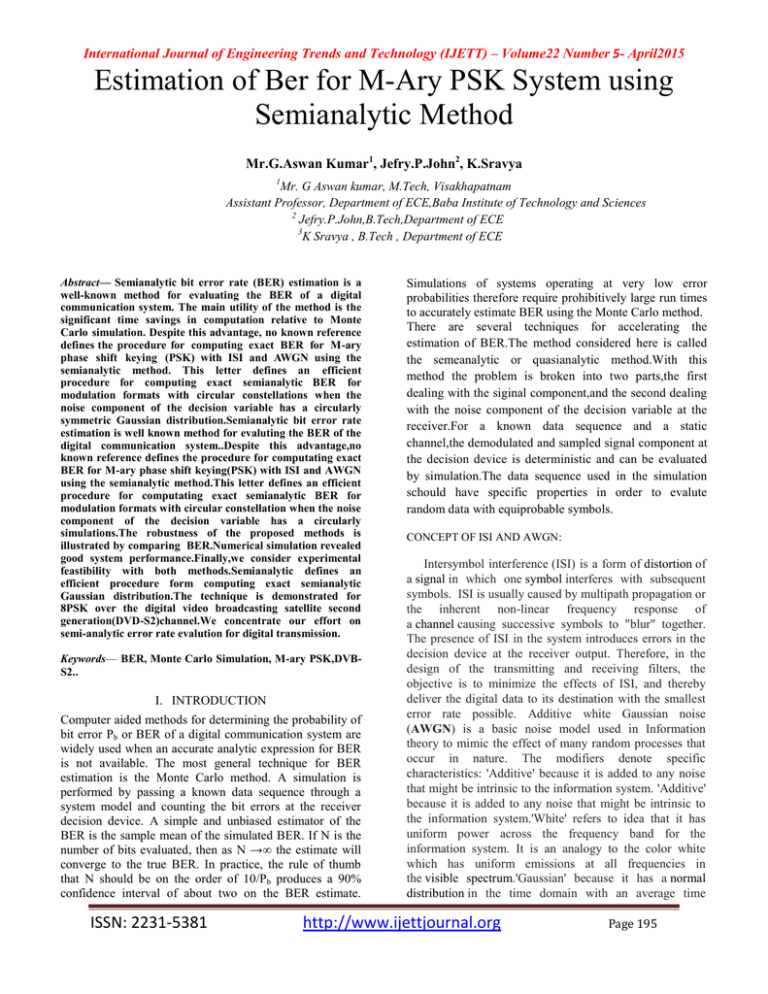
International Journal of Engineering Trends and Technology (IJETT) – Volume22 Number 5- April2015 Estimation of Ber for M-Ary PSK System using Semianalytic Method Mr.G.Aswan Kumar1, Jefry.P.John2, K.Sravya 1 Mr. G Aswan kumar, M.Tech, Visakhapatnam Assistant Professor, Department of ECE,Baba Institute of Technology and Sciences 2 Jefry.P.John,B.Tech,Department of ECE 3 K Sravya , B.Tech , Department of ECE Abstract— Semianalytic bit error rate (BER) estimation is a well-known method for evaluating the BER of a digital communication system. The main utility of the method is the significant time savings in computation relative to Monte Carlo simulation. Despite this advantage, no known reference defines the procedure for computing exact BER for M-ary phase shift keying (PSK) with ISI and AWGN using the semianalytic method. This letter defines an efficient procedure for computing exact semianalytic BER for modulation formats with circular constellations when the noise component of the decision variable has a circularly symmetric Gaussian distribution.Semianalytic bit error rate estimation is well known method for evaluting the BER of the digital communication system..Despite this advantage,no known reference defines the procedure for computating exact BER for M-ary phase shift keying(PSK) with ISI and AWGN using the semianalytic method.This letter defines an efficient procedure for computating exact semianalytic BER for modulation formats with circular constellation when the noise component of the decision variable has a circularly simulations.The robustness of the proposed methods is illustrated by comparing BER.Numerical simulation revealed good system performance.Finally,we consider experimental feastibility with both methods.Semianalytic defines an efficient procedure form computing exact semianalytic Gaussian distribution.The technique is demonstrated for 8PSK over the digital video broadcasting satellite second generation(DVD-S2)channel.We concentrate our effort on semi-analytic error rate evalution for digital transmission. Keywords— BER, Monte Carlo Simulation, M-ary PSK,DVBS2.. I. INTRODUCTION Computer aided methods for determining the probability of bit error Pb or BER of a digital communication system are widely used when an accurate analytic expression for BER is not available. The most general technique for BER estimation is the Monte Carlo method. A simulation is performed by passing a known data sequence through a system model and counting the bit errors at the receiver decision device. A simple and unbiased estimator of the BER is the sample mean of the simulated BER. If N is the number of bits evaluated, then as N →∞ the estimate will converge to the true BER. In practice, the rule of thumb that N should be on the order of 10/Pb produces a 90% confidence interval of about two on the BER estimate. ISSN: 2231-5381 Simulations of systems operating at very low error probabilities therefore require prohibitively large run times to accurately estimate BER using the Monte Carlo method. There are several techniques for accelerating the estimation of BER.The method considered here is called the semeanalytic or quasianalytic method.With this method the problem is broken into two parts,the first dealing with the siginal component,and the second dealing with the noise component of the decision variable at the receiver.For a known data sequence and a static channel,the demodulated and sampled signal component at the decision device is deterministic and can be evaluated by simulation.The data sequence used in the simulation schould have specific properties in order to evalute random data with equiprobable symbols. CONCEPT OF ISI AND AWGN: Intersymbol interference (ISI) is a form of distortion of a signal in which one symbol interferes with subsequent symbols. ISI is usually caused by multipath propagation or the inherent non-linear frequency response of a channel causing successive symbols to "blur" together. The presence of ISI in the system introduces errors in the decision device at the receiver output. Therefore, in the design of the transmitting and receiving filters, the objective is to minimize the effects of ISI, and thereby deliver the digital data to its destination with the smallest error rate possible. Additive white Gaussian noise (AWGN) is a basic noise model used in Information theory to mimic the effect of many random processes that occur in nature. The modifiers denote specific characteristics: 'Additive' because it is added to any noise that might be intrinsic to the information system. 'Additive' because it is added to any noise that might be intrinsic to the information system.'White' refers to idea that it has uniform power across the frequency band for the information system. It is an analogy to the color white which has uniform emissions at all frequencies in the visible spectrum.'Gaussian' because it has a normal distribution in the time domain with an average time http://www.ijettjournal.org Page 195 International Journal of Engineering Trends and Technology (IJETT) – Volume22 Number 5- April2015 domain value of zero. AWGN is often used as a channel model in which the only impairment to communication is a linear addition of wideband or white noise with a constant spectral density (expressed as watts per hertz of bandwidth) and a Gaussian distribution of amplitude. II. PSK CONSTELLATION WITH ISI AND AWGN The M signal waveforms for ideal M-ary PSK are repre- sented as Sm (t) = g (t) cos (ωc t + θm) m = 0, 1, M − 1 (1) Where g(t) is a pulse waveform used to shape the spectrum of the transmitted signal and θm is the information-bearing phase angle which takes M possible values m = 0, 1, M-1 (2) If an ideal PSK signal is optimally demodulated, then using complex phasor notation, each of the complex decision variables takes one of the following M values m=0, 1, M-1 (3) Where ε is the energy of the spectrum shaping pulse and is given in terms of bit energy Eb by ε= log2 (M) Eb. Fig.1 shows the ideal symbol locations Sm and decision regions Rm for 8PSK. When distortions due to channel effects or modem imperfections are present, the received decision variables will differ from the M ideal points, and their locations will be data dependent due to ISI. In this context, ISI will refer to the effects of both linear and non-linear time invariant distortions with memory. Assuming equiprobable symbols, then in order to completely characterize the ISI of a channel with L symbol periods of memory, it is sufficient to consider all possible sequences of L symbols. A maximal length pseudorandom ML symbol sequence will satisfy this property. For M=2, linear feedback shift registers can be used to generate maximal length pseudorandom bit sequences. For M>2, efficient Fig. 1. Ideal 8PSK symbols Sm and decision regions Rm. Methods for generating maximal length pseudorandom symbol sequences have also been proposed [6] [7]. With the addition of cyclic prefixes and postfixes of L symbols each, a simulation using one cycle of a ML length pseudorandom symbol sequence is sufficient to emulate equiprobable data symbols. Therefore, performing a simulation using ML +2L symbols from a maximal length ML symbol sequence, and discarding the first and last L demodulated and detected decision variable points, the resulting ML decision variable points will completely characterize the effect of the system ISI on the signal. This set of decision variables can be defined in terms of their respective magnitudes and phases or in-phase and quadrature components k= 0, 1,…., - 1 (4) When AWGN is present at the receiver input, the decision variables are -1 (5) For a receiver having arbitrary discrete time detection filter with impulse response h(n), the noise component nk at the filter output is a sequence of complex Gaussian distributed random variables each with mean zero and variance given by = = (6) Where σr2 and σi2 are the variances of the real and imaginary components respectively, and N0 is the one-sided power spectral density (psd) of the AWGN. ISSN: 2231-5381 http://www.ijettjournal.org Page 196 International Journal of Engineering Trends and Technology (IJETT) – Volume22 Number 5- April2015 III. BIT ERROR RATE CALCULATION Since a pseudorandom symbol sequence emulates equiprobable symbols, averaging the BER over all of the resulting In terms of the transformed variables, (8) becomes (11) In this way, only the error event probabilities for decision variables from decision region R0 need to be computed. This situation is depicted in Fig. 2. Expressing (11) in vector notation produces (12) Where p (k) is a column vector with elements Pn/0(sk) for n=1, 2,. . . ,M-1 and wT(k) is a row vector with elements taken from row m and columns 1 through M-1 of the weight matrix W_. Note that column 0 need not be included because this corresponds to a correct decision, and the weight is therefore always 0. Substituting (12) into (7) produces (13) Fig. 2. 8PSK decision regions showing half-planes, quadrant planes, and correction planes. A single noise free decision variable sk with ISI is also shown. Decision variable points will determine the BER of the system. The bit error probability is therefore given by (7) Where Pb (Sk, m) is the bit error probability for decision variable Sk with correct decision region Rm. An expression for Pb (Sk, m) is The main difficulty in evaluating (13) is the computation of the individual error event probabilities Pn/0(sk) for n=1,2,. . . , M-1. The probabilities could be evaluated for each decision variable point by numerically computing M1 double integrals over the error event regions. By generalizing the method presented in [5] to include ISI, a significant improvement in computational speed and accuracy can be achieved relative to direct numerical integration. This is done by expressing a set of half-plane, quarter-plane, and correction plane probabilities in terms of the desired Pn/0(sk) and solving this system of equations for Pn/0(sk). For an M-ary PSK decision variable specified by sk as shown in Fig. 2 and circularly symmetric additive Gaussian distributed noise, M/2 independent half-plane probabilities and M/4 independent quarter-plane probabilities can be written. (8) The term Pn/m (Sk) is the probability that the received decision variable Sk from region Rm would fall in decision region Rn under the influence of noise, and wmn is the number of bit errors that occurs in this event. For an arbitrary bit mapping, the bit error weight matrix W with elements wmn can be generated from the weight matrix for the binary bit mapping by swapping rows and then columns according to the desired symbol assignment. Equation (8) can be simplified by noting that each received decision variable can be rotated to decision region R0 provided that the bit error weight matrix W is appropriately transformed as well. The rotated decision variable from decision region Rm is (9) The required transformation for the W matrix consists of a cyclic left shift of row m by m positions. This operation can be expressed as (14) (15) In addition to the 3M/4 probabilities specified by (14) and (15), the remaining required M/4-1 independent probabilities can be found using the following correction plane probabilities. (16) Where ik = rk cos (θk) and qk = rk sin (θk). The expressions for the probabilities (14)-(16) are given by integrating the circularly symmetric Gaussian pdf over the specified regions. Evaluating the inner integral of (16) produces (10) ISSN: 2231-5381 http://www.ijettjournal.org Page 197 International Journal of Engineering Trends and Technology (IJETT) – Volume22 Number 5- April2015 (17) Where the integrand term is (24) Substituting (24) into (13) produces the desired expression for the bit error probability (25) (18) The values for the correction plane probabilities ci(k) specified by (17) and (18) can be evaluated by numerical integration. Expressions for the half-plane, quarter plane, and correction plane probabilities can also be written in terms of the desired probabilities Pn/0(sk). Fig. 3. Simulation model. Scatter plot 1 0.5 Quadrature (19) (20) 0 -0.5 -1 -1 (21) The system of linear equations specified by (19)(21) can be expressed compactly in matrix-vector notation as -0.5 0 In-Phase 0.5 1 Fig. 4. Noise free decision variable points SK used for the semianalytic BER computation of uncoded 8PSK and the DVB-S2 channel. IV. APPLICATION EXAMPLE z(k) = Ap(k) (22) Where z(k) is a known column vector of h(k), q(k), and c(k) values, A is a matrix of known coefficients, and p(k) is an unknown column vector of Pn/0(sk) values. The matrix A and the form of the vector z(k) are determined by the PSK modulation order M. For 8PSK they are given by (23) The system of equations specified by (22) can be solved for the unknown probabilities ISSN: 2231-5381 To serve as an example of the proposed method, the BER for uncoded 8PSK with the DVB-S2 satellite channel was evaluated and compared to the results of Monte Carlo simulation. A block diagram of the model used for the simulations is shown in Fig. 3. The characteristics of the channel model are specified in the DVB-S2 standard [8]. The complex baseband simulations were performed using an 8PSK pseudorandom symbol sequence sampled at 16 samples/symbol. A Gray coded symbol bit mapping was used and the symbol pulse shaping filter had a square-root raised cosine magnitude response with a roll-off factor of 0.35. A 10th order rational transfer function was used to approximate the specified frequency response of the input multiplexer (IMUX) filter and a 6th order rational transfer function was used for the output multiplexer (OMUX) filter. The signal at the traveling wave tube amplifier (TWTA) model input was scaled to a level corresponding to 1dB of input back off (IBO). The TWTA produces a pass band nonlinearity that was modeled using the nonlinearized amplitude modulation-to amplitude modulation (AM/AM) and amplitude modulation to-phase modulation (AM/PM) conversions specified in the standard. The output from the OMUX filter was applied to a square-root http://www.ijettjournal.org Page 198 International Journal of Engineering Trends and Technology (IJETT) – Volume22 Number 5- April2015 raised-cosine detection filter with roll-off factor 0.35 and then interpolated by 4. The optimal sample phase, carrier phase, and gain were then jointly determined to produce decision variables with the minimum mean squared error relative to the ideal symbol locations. Fig 7 SNR Vs BER for 16-PSK Scatter plot Fig. 5. Semianalytic and Monte Carlo BER as a function of SNR for uncoded 8PSK and the DVB-S2 channel. 1 Quadrature 0.5 0 -0.5 -1 -1 -0.5 0 In-Phase 0.5 Fig 8 Constellation diagram for 32-PSK Fig 6 Constellation diagram for 16-PSK ISSN: 2231-5381 http://www.ijettjournal.org Page 199 1 International Journal of Engineering Trends and Technology (IJETT) – Volume22 Number 5- April2015 Carlo BER estimate, 10173 cycles of the 32768 length pseudorandom symbol sequence were simulated for a total of approximately 109 bits. AWGN was applied to the receiver detection filter and the resulting decision variable noise components were scaled and added to the deterministic components to emulate the desired effective SNR at the receiver input. Bit errors were then counted to produce BER estimates. The results of the semianalytic and Monte Carlo simulations are plotted in Fig. 5. The differences between the results are consistent with the expected estimation error for a Monte Carlo simulation of 109 bits in length. While the Monte Carlo simulation produced no errors when the SNR was greater than 22dB, the semianalytic method produced accurate results at all signal-to-noise ratios. V. CONCLUSION Fig9 SNR Vs BER for 32-PSK Fig 10 BER for M-ary PSK (M = 8, 16 and 32) From [8] it can be seen that the passband channel memory spans approximately 5 symbol periods due to the IMUX and OMUX filters, so a value of L=5 was chosen. For the semianalytic BER computation, only one cycle of a length 32768 pseudorandom symbol sequence with a small cyclic prefix and postfix was simulated. After discarding the decision variable points corresponding to the prefix and postfix, the resulting set of points shown in Fig. 4 was used to compute the BER according to (25). For the Monte ISSN: 2231-5381 A fast and accurate method for computing semianalytic BER for PSK with ISI and AWGN has been presented. Two simplifications were applied relative to directly evaluating the semianalytic BER using numerical integration. First, the decision variable points were each rotated to decision region R0, and the bit error weight matrix was appropriately transformed. Second, the process of numerically computing M-1 double integrals for each decision variable point was simplified to require only the evaluation of complementary error functions and M/4-1 single integrals. The technique is applicable to ideally demodulated and matched filter detected PSK with a static channel distortion, and produces an exact BER result when the received noise has a circularly symmetric Gaussian distribution. The basic approach can also be applied for any circularly symmetric noise distribution by simply rederiving the half-plane and correction-plane probabilities of (14) and (16) for the desired pdf. An extension of the technique to include synchronization errors in the demodulator is described in [3] and is referred to as the statistical averaging method. In a similar way, the technique can also be extended to frequency non-selective slowly fading channels [9]. The BER specified by (25) that accounts for time invariant distortions such as high power amplifier nonlinearity and non-ideal filtering is first expressed as a function of α r k, α i k , and α q k, where α accounts for the effect of fading. The resulting expression is then averaged over the pdf of α. Depending on the pdf considered; some of the integrals may be evaluated analytically to produce a computationally efficient procedure for determining exact BER in a flat fading environment. REFERENCES [1] M. Jeruchim, ―Techniques for estimating the bit error rate in the simulation of digital communication systems," IEEE J. Select. Areas Commun. Vol. SAC-2, pp. 153-170, Jan. 1984. http://www.ijettjournal.org Page 200 International Journal of Engineering Trends and Technology (IJETT) – Volume22 Number 5- April2015 [2] W. Tranter and K. Kosbar, ―Simulation of communication systems," IEEE Commun. Mag., vol. 32, no. 7, pp. 26-35, July 1994. [3] M. Jeruchim, P. Balaban, and K. Shanmugan, Simulation of Communications Systems. New York: Plenum, 1992. [4] F. Gardner and J. Baker, Simulation Techniques: Models of Communications Signals and Processes. New York: Wiley, 1997. [5] M. Irshid and I. Salous, ―Bit error probability for coherent M-ary PSK systems," IEEE Trans. Commun., vol. COM-39, pp. 349-352, Mar. 1991. [6] E. Pinto and J. Brandao, ―On the efficient use of computer simulated digital signals to evaluate performance parameters," IEEE J. Select. Areas Commun. vol. SAC-6, pp. 52–57, Jan. 1988. [7] M. Kavehrad and P. Balaban, ―Digital radio transmission modeling and simulation," in Proc. IEEE GLOBECOM ‘89, Dallas, TX, pp. 12891294, Nov. 1989. [8] ETSI EN 302 307 V1.1.1 (2005-03); ―Digital video broadcasting (DVB); second generation framing structure, channel coding and modulation systems for broadcasting interactive services, news gathering and other broadband satellite applications." [9] J. Proakis, Digital Communications, 3rd Ed. New York: McGraw Hill, 1995. ISSN: 2231-5381 http://www.ijettjournal.org Page 201
